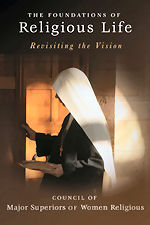Posted May 18, 2009
Book: The Foundations of Religious Life: Revisiting the Vision
Author: Council of Major Superiors of Women Religious
Ave Maria Press. Notre Dame, IN. 2009. Pp. 244
An Excerpt from the Jacket:
In this collection of foundational articles, the Council of Major Superiors of Women Religious articulate its perspective on religious life, suggesting that their commitment to a more visibly countercultural life and ministry is what sustains their orders and attracts young women to their communities.
An Excerpt from the Book:
Just as the mission of Christ is a communication of is being as Son, the mission of the Church is a communication of herself. In this regard, it is essential to see that the communion Christ generates among his followers is both with himself and with each other. It is both vertical and horizontal, not as separate events, but as two dimensions of the same event. Fellowship with God is precisely that which guarantees fellowship with each other. Without Christ’s disclosure of the Father, it is inconceivable that man should be capable of seeing and loving one another as God sees and loves him. Thus, these two dimensions of communion are not simply extrinsically connected. And although there is a hierarchy, it is dangerous to dismiss the human dimension of communion as merely instrumental to its divine dimension. Rather, as Alexander Schmemann contends, creation itself is the very “stuff” of our communion with God. In a word, these two dimensions somehow imply each other, such that it is existentially impossible to separate them. This is more easily grasped when one understands that communion is not a physical, tangible thing, but a relation. And it is precisely in relation to God, and only in relation to him, that man is in relation to other men. Indeed, “while the various currents of human thought both in the past and at the present have tended and still tend to separate theocentrism and anthropocentrism, and even to set them in opposition to each other, the Church, following Christ seeks to link them up in human history in a deep and organic way.
Table of Contents:
1. Religious consecration — a particular form of consecrated life
2. The spousal bond
3. The threefold response of the vows
4. Communion in community
5. Evangelical mission
|
|
|

